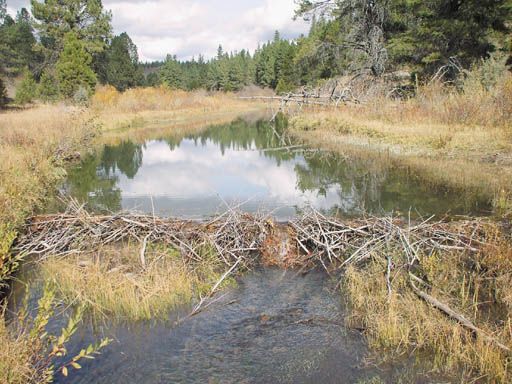Beavers make their presence known
Published 10:19 am Sunday, September 19, 2010

- Beavers thrive in parts of Baker County. The industrious animals built this dam along the North Fork of the Burnt River near Whitney several years ago.
The beaver, alone among animals, was honored not only with one whole side of Oregon’s flag but also as the state’s nickname.
But quite contrary to what those symbolic awards might imply, the
thick-furred rodents have hardly had an easy go of it around here.
Our ancestors cherished beavers not for their industrious nature and engineering skill, but rather for their pelts.
For decades before anybody thought to dip a gold pan in a Western stream, beaver fur was the region’s most valuable currency.
Lewis and Clark, in reporting to President Thomas Jefferson on their
historic journey to the Pacific, extolled the abundance of beavers and
otters, and the fortunes that could be made.
Just a few years later, John Jacob Astor’s Pacific Fur Company
established a post at the mouth of the Columbia, a place that would
become Astoria.
Hundreds of thousands of beaver were killed over the next half century.
By the time Oregon became a state, on Feb. 14, 1859, our namesake animal had been eradicated from many river drainages.
Since then beaver populations have recovered, though the animals
aren’t nearly as numerous as they were before widespread trapping
started.
Still, you don’t have to go far to see evidence of their presence.
You don’t even have to leave Baker City, actually.
“We’ve seen quite a bit of beaver activity the past two years right here in town along the Powder River,” said Nick Myatt, district wildlife biologist at the Oregon Department of Fish and Wildlife’s (ODFW) Baker City office.
Earlier this month, beavers felled a mature cottonwood tree that almost hit the Lions Club’s shelter beside the Leo Adler Memorial Parkway, just south of D Street, Myatt said.
Perhaps the best place, though, to see beavers’ handiwork is upstream at the U.S. Forest Service’s Powder River Recreation Area.
It’s just off Highway 7 below Mason Dam, about 14 miles from Baker City.
There, a colony of beavers constructed a large dam below the footbridge adjacent to the paved parking area.
“It’s a good educational viewing opportunity,” Myatt said. “I took a group of kids up there this spring.”
Although the beavers abandoned the dam when the Baker Valley Irrigation District released more water from the dam to supply farms and ranches, Myatt expects they’ll rebuild the structure as the river recedes this fall.
“There’s a lot of excellent habitat along that stretch of river,” he said.
Myatt’s ambivalence about beavers is based on the vastly different effects they can have, differences based largely on where the animals settle.
“They’re incredible animals that do great things for wildlife habitat,” Myatt said. “But they can also cause big problems, especially in areas like Baker County where we have so much irrigation. Ditches with slow-moving water are perfect for beavers.”
ODFW’s basic goal, he said, is to encourage beavers to colonize areas where they can improve habitat.
“We want beavers in appropriate places,” Myatt said.
Elsewhere, private property owners can legally trap or otherwise kill beavers that cause damage.
There are also non-lethal tactics, Myatt said, such as fitting screens over culverts to prevent beavers from building dams.
ODFW installed a screen earlier this year at the outlet of a fishing pond near North Powder, where a beaver had repeatedly built a dam that flooded the road leading to the pond and adjacent fields.
The screen seems to be working as designed, Myatt said.
In the past ODFW has tried to accentuate the beavers’ positive effects by live-trapping animals on private land and moving them to public property.
One such place is the Powder River below Mason Dam.
The agency released several beavers there about 1992.
However, the beavers moved downstream and damaged private property, according to ODFW records.
Also, beaver dams flooded the wheelchair-accessible trail at the Forest Service recreation area.
Myatt figures the beavers that built the dam there earlier this year moved in from elsewhere; ODFW hasn’t released any beavers there since the early 1990s, he said.
The benefits of beavers are multiple, Myatt said.
First, the pools that form behind beaver dams shelter fish, in particular young fish.
Those pools also tend to raise the water table and, because they release water gradually, streams with beaver dams aren’t as likely to go dry during drought.
Water spreading behind dams also creates larger swathes of wetland habitat for reptiles, amphibians and waterfowl, Myatt said.
Beavers also do tasks that the Forest Service and BLM usually have to pay somebody with a chainsaw to do, he said.
Although beavers eat only deciduous trees, in particular cottonwoods and willows, the animals will also fell ponderosa pines and other conifers.
Federal agencies do the same thing because conifers, by casting shade on sun-loving deciduous trees, can eventually crowd out the latter, Myatt said.
At the Powder River Recreation Area, beavers have gnawed down several mature ponderosas.
“I always wonder what they think about getting a big mouthful of pine sap,” Myatt said.
On the negative side of the ledger, beavers can wreak havoc not only on irrigation ditches, but their dams can flood roads and crop fields, and their appetites make no distinction between a wild tree and one that shades your deck or yard.
Myatt said he has received several calls from Baker City residents who have either had beavers chew on their ornamental trees, or are worried that will happen.
Fortunately, he said, protecting trees is relatively easy: Just wrap the tree with chicken wire or some other metal material from the ground up at least two feet.
Banishing beavers from farms and ranches is a trickier proposition, he said, since the animals are inclined to stay in suitable habitat.
Cal Foster, whose family’s ranch covers much of Bowen Valley, along Highway 7 just south of the Baker City limits, said beavers tried to dam some of his irrigation headgates almost daily last year.
He said his brother-in-law, John Wirth, trapped several beavers along the Powder River, which flows through Bowen Valley.
“I haven’t seen any fresh activity this summer,” Foster said.
Although private landowners don’t need permits to kill beavers that cause damage, other trappers must register with the state.
There’s about 10 registered trappers in Baker County, Myatt said. On average they take about 60 beavers per year.
Statewide, ODFW said licensed trappers kill about 2,000 beavers per year – down from 6,000 or so annually in the 1980s.
Although the agency doesn’t conduct a beaver census in Baker County, Myatt figures the population is rising.
Beaver colonies are active in many parts of the Burnt River Valley, including the North Fork and in the canyon between Bridgeport and Durkee.
Myatt said he’s also seen beaver dams along the lower Powder River between Keating and Richland, along the lower reaches of Eagle and Pine creeks in the Panhandle, and in the dredge tailing piles at the upper end of Phillips Reservoir.





